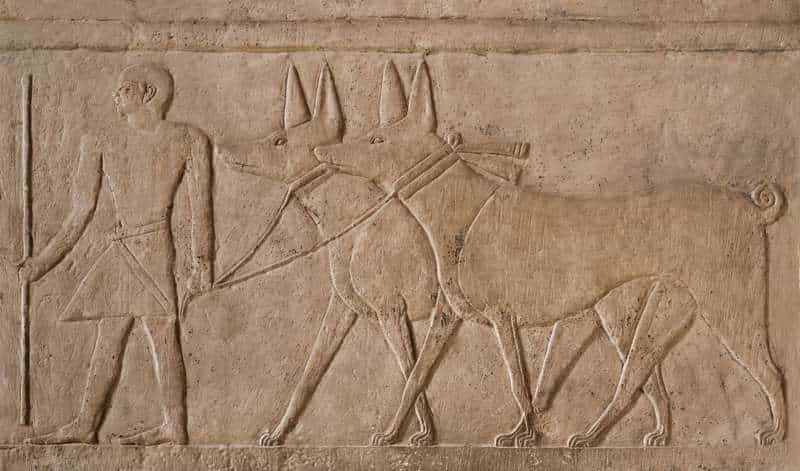Throughout history, humans have developed special bonds with various animals, often regarding them as beloved companions or even family members. This deep connection was equally present in ancient Egypt, where numerous records highlight the affection the Egyptians had for their pets.
From pharaohs to commoners, people of ancient Egypt showed great fondness for their pets, including dogs, cats, and monkeys. There were also more unusual choices, such as gazelles and ducks. These animals were treated with utmost care and respect, both during their lives and in the afterlife.
Dogs, in particular, were cherished as the top choice of pets in ancient Egypt. Historical evidence points to their significant role in Egyptian society. A notable example is the greyhound named Abutiu, who lived during the 6th Dynasty (2345-2181 BC).
Abutiu was especially beloved by a pharaoh whose identity remains unknown, illustrating the deep bond between the Egyptian royalty and their canine companions.
The Cherished Dogs of Ancient Egypt
In 1935, American archaeologist George A. Reisner unearthed a tombstone inscribed with the name Abutiu, which translates to “pointed-eared.” This discovery revealed that the dog had been afforded a grand burial, a testament to the profound affection a pharaoh had for his canine companion. Abutiu was laid to rest in the Giza necropolis, though the exact location of this tomb remains undiscovered.
The inscription found by Reisner expressed the pharaoh’s sorrow over Abutiu’s passing: “The dog who served His Majesty as a guard, Abuwtiyuw is his name. His Majesty decreed that he be interred with a coffin from the royal treasury, ample linen, and incense. Perfumed ointment was also provided, and a tomb was constructed in his honor. His Majesty did this to show his respect.”
In some instances, dogs were buried alongside their owners in the same tomb. If the dog died before its master, it was mummified and placed in the grave to accompany the owner in the afterlife.
Conversely, if the owner passed away first, the dog would often be interred in a nearby tomb, as the owner’s grave would already be sealed.
One notable example is the dog found in the tomb of Hay-min in Abydos, dating to the 30th Dynasty (380-343 BC). This dog was discovered curled up at its owner’s feet, mirroring the canine poses depicted in medieval tombs. Unfortunately, the dog’s name remains unknown.
Another preserved canine is Aya, whose wooden coffin bears a complete offering formula. While Aya’s owner is not identified, this burial is well-documented. Additionally, a well-preserved dog mummy was found in tomb KV 50 in the Valley of the Kings, buried alongside a baboon. Scholars speculate that this dog might have belonged to Pharaoh Amenhotep II, given the tomb’s proximity to Amenhotep II’s burial site.
Cats and Exotic Companions
Cats enjoyed a status akin to that of dogs in ancient Egypt. A notable example is Tamyt, a cat mummy belonging to Prince Thutmose, the eldest son of Amenhotep III. Tamyt’s affection was commemorated with a beautifully crafted limestone sarcophagus depicting the cat before an offering altar, giving the impression of a revered human figure.
In addition to cats and dogs, some ancient Egyptians kept more unusual pets, such as gazelles. A prominent case involves Princess Isetemkheb D, the wife of a high priest of Amun during the 21st Dynasty (1069-664 BC).
Upon her death, her gazelle was meticulously wrapped in royal cloths, adorned with necklaces, and interred in a sycamore wood sarcophagus shaped like the animal. Another gazelle was discovered in the tomb of Ankhshepenwepet, from the 25th Dynasty (747-656 BC).
Other exotic pets included baboons and ducks, found in various graves in the Valley of the Kings. Notably, baboons had their tusks removed to prevent any harm to their owners from their sharp teeth.
A particularly intriguing case involves the tomb of the priestess of Amun, Maatkare. A small mummy initially believed to be her child was later identified through x-ray analysis as a monkey.
Monkeys were highly valued pets in ancient Egypt and continued to be popular into Roman times due to their entertaining antics and acrobatics.
Mummification of Pets
The mummification of animals in ancient Egypt was as meticulous as that of humans. Pets were embalmed with a comparable level of sophistication, starting with the evisceration process, though the incision was not always made on the left side as it was for humans.
Following evisceration, the body was dried using natron or salt, then anointed with aromatic oils and resin before being wrapped in linen bandages. The aim was to preserve the animals in a life-like manner, similar to human mummies.
For instance, baboons were treated with linen bundles placed inside their torsos to maintain their shape. In the case of Princess Isetemkheb D’s gazelle, its viscera were reintroduced into its body—a practice typical of the 21st Dynasty. This careful mummification ensured that these cherished animals could accompany their owners into the afterlife.
Source: Carme Mayans, National Geographic








